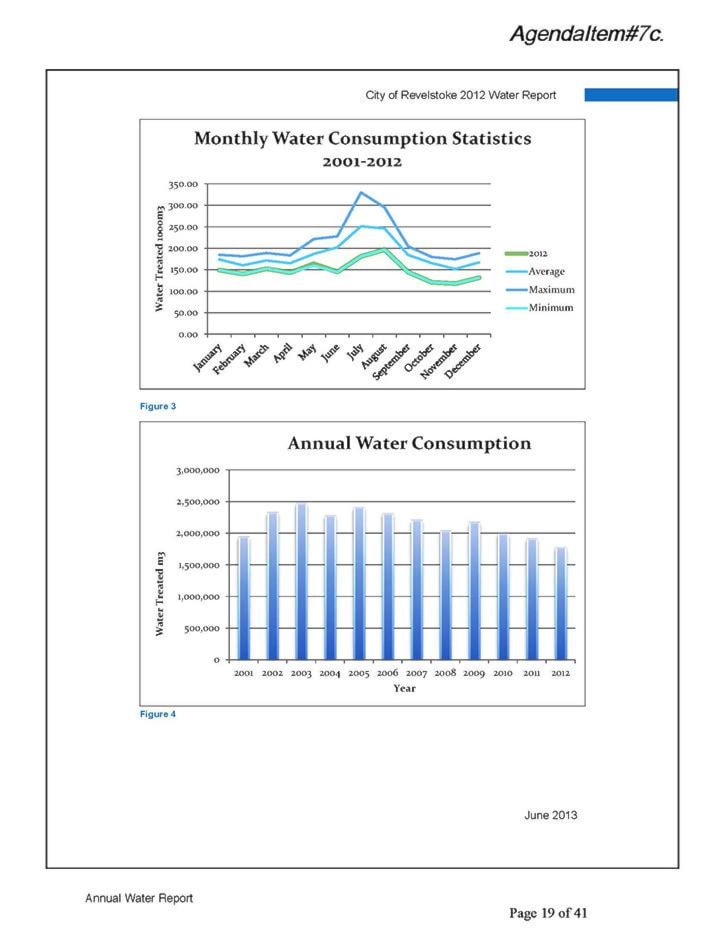Revelstoke water usage dropped to its lowest point this millennium, totalling about 1.9 million cubic meters in 2012, down significantly from a high of 2.5 million cubic metres in 2003. The average has been 2.16 million litres.
The stats came in the new 2012 Annual Water Report.
What’s driving the drop, which has trended downwards for the past three years? It’s hard to say with scientific certitude, said City of Revelstoke engineering director Mike Thomas.
“The city has been fairly proactive at targeting old pipes for reductions,” he said, adding new lawn watering restrictions also play a part. The restrictions now limit the number of hours residents can water on watering days. “Reducing it down to mornings-only does make a big difference. There’s been some better understanding and knowledge about water conservation from the community,” Thomas said, adding education and enforcement effort have helped.
In the annual report, Revelstoke’s water quality earned great grades. Monthly coliform bacteria testing at locations around Revelstoke didn’t turn up any problems. Canadian drinking water guidelines allow for coliform bacteria up to 10 ‘colony forming units’ (CFU) per 100 millilitres of water. All Revelstoke tests came back at less than one CFU per 100 millilitres.
Although the water usage reduction is a success, more work is needed to understand the issues, Thomas said.
Water loss and water metering study update is coming soon
Revelstoke City Council will soon receive a water loss and water metering study done in conjunction with the Columbia Basin Trust.
While it may be tempting to suspect your water-hog neighbour is single-handedly draining the water reservoir, determining the causes of water usage is much more difficult. Leaks are buried underground and taps are located behind closed doors; where it all goes is part mystery.
Water loss due to leaky pipes “can be anywhere from 10 to 50 per cent of the water that you’re actually treating,” Thomas said.
Revelstoke has 98-kilometres of water mains. 74 per cent of Revelstoke water mains are more than 26 years old; 15 per cent of them are more than 50 years old. It’s a patchwork of cast iron, ductile iron, galvanized metal, asbestos-concrete and PVC pipes, all of which have different operational lives. Older pipes can even last longer than newer ones, depending on the material they are made from.
Thomas estimated 20 to 30 per cent of water supply could be regained through a better understanding of leakage.
The water loss and metering study will explore the topics and suggest routes forward.
“For us, understanding that is the first step. Once we understand where our losses are, that will inform how we move forward,” Thomas said.
Always controversial, water metering has been discussed as an idea in the past. A less-understood option within the metering spectrum is zone metering, which basically means metering arterial pipes to gain a better understanding of where, when and how much is being used.
For example, a zone meter could detect a big, seasonal spike in a certain neighbourhood, helping the city understand where and who the big users are.
Thomas said he’s interested to see the results of the study, “to see if there’s a good argument for metering or not.”
His gut feeling? No, water metering isn’t in the pipes in the short-term.
“I wouldn’t want to presuppose the outcome of the report. I’d be surprised if we’re going to metering in the short term,” Thomas said. “It doesn’t feel like it’s the most necessary thing to be focusing on right now. I think we’ve got lots of other infrastructure things we can spend our money on.”
After all, the driver of water-treatment decisions really is cost; balancing out capital expenditure, financing, maintenance costs, operational costs and those for any new programs like education and, potentially, metering.
Operational costs were a downside on the 2012 water report; costs per cubic metre jumped from $0.62 in 2010 to $0.89 this year. Thomas couldn’t pinpoint the reason, but said fixed costs with lower volumes of water were likely a driver.
Cross connection plan
The city is also working on a “cross connection” program. It seeks to address the potential for water contamination from high-risk water connections. For example, contaminants from an industrial user could enter the system due to faulty connection or broken pipes.
The city also has a number of pipe replacement and maintenance projects ongoing in 2013, including installing a new main and pressure-reducing valve on CPR Hill, a new main on Cedar Street on CPR Hill, and abandoning a main on the Trans-Canada Highway.
The water really is better on the other side of the highway
Oh, and the water does taste better in some parts of Revelstoke. Although the main source of water is the Greeley Creek treatment plant, the city tops up supply using the secondary well located at the Revelstoke Golf Course. It’s used all-year round, even more so during the summer. The groundwater source contains higher concentrations of the mineral manganese. The mineral is not a health concern, but it does give water a metallic, bitter taste and an odour. It also leaves reddish-brown stains on your fixtures and clothes, and can interfere with pipes and water heaters. Simple steps can be taken to alleviate most of the issues.
Due to the proximity to the well, Columbia Park homes get way more well water than the rest of Revelstoke, although some well water is distributed throughout some areas of town.
